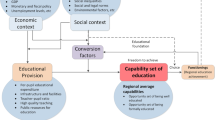Abstract
Relative location can be a critical determinant of the success or failure of a college. Central Place Theory, as developed in geographic studies of population distribution patterns, can provide insights into the problem of evaluating college locations. In this way the preferences of present and future students can be balanced against economic, academic, and political considerations.
Similar content being viewed by others
References
Carnegie Commission on Higher Education (1971).New Students and New Places: A Report. New York: McGraw-Hill.
Christaller, W. (1933).Die Zentralen Orte in Süddeutschland ... Jena; also (1966).Central Places in Southern Germany. (trans. Baskin, C. W.). Englewood Cliffs, New Jersey: Prentice-Hall. [Christaller's theories as developed in economic and geographic thought have been reviewed by Berry, B. J. L., and Pred, A. (1961/1965).Central Place Studies. Philadelphia: Regional Science Institute.]
Gossman, C. S. (1967).Migration of College and University Students: State of Washington. Seattle: Washington State Census Borad.
Jencks, W., and Riesman, D. (1968).The Academic Revolution. New York: Doubleday.
Kariel, H. G. (1968). “Student Enrollment and Spatial Interaction.”Annals of Regional Science, 2:2
Kelley, R. L.,ed. (1921). “The Preliminary Report of the Association Commission on the Distribution of Colleges.”Bulletin of the Association of American Colleges 7:4.
McConnell, H. (1965). “Spatial Variability of College Enrollment as a Function of Migration Potential.”Professional Geographer, 17:6.
Rudolph, F. (1962).The American College and University: A History. New York: Vintage.
Schmid, C. P., and Gossman, C. S. (1968).Migration of College and University Students in the United States. Seattle: University of Washington Press.
Schofer, J. P. (1971). “On Some Geographic Aspects of Higher Education in the United States: A Systems Approach.” Unpublished dissertation. University Park, Pennsylvania: The Pennsylvania State University.
Schofer, J. P. (1973). “The Geopolitics of “Youth Power”.”College and University 49:1.
Stewart, J. Q. (1941). “The ‘Gravitation’, or Geographical Drawing Power of a College.”AAUP Bulletin 47.
Stouffer, A. S. (1940). “Intervening Opportunities: A Theory Relating to Mobility and Distance.”American Sociological Review 5.
Tewksbury, D. G. (1932).The Founding of American Colleges and Universities Before the Civil War. New York: Teachers College, Columbia University.
United States Reports of Supreme Court Cases (1964).Reynolds vs. Sims. 377:533.
Withey, D. (1959).The Public's Picture of Higher Education in the State of Michigan. Ann Arbor, Michigan: Survey Research Center.
Author information
Authors and Affiliations
Rights and permissions
About this article
Cite this article
Schofer, J.P. Determining optimal college locations. High Educ 4, 227–232 (1975). https://doi.org/10.1007/BF01569171
Issue Date:
DOI: https://doi.org/10.1007/BF01569171




